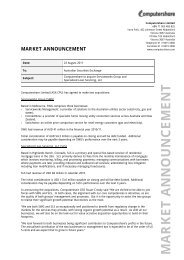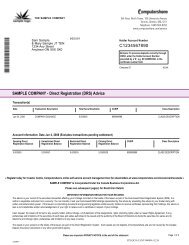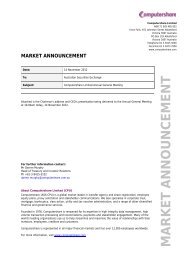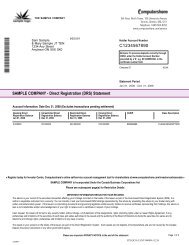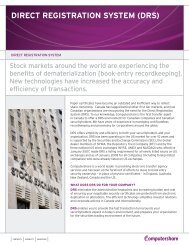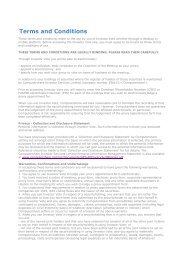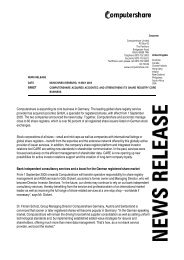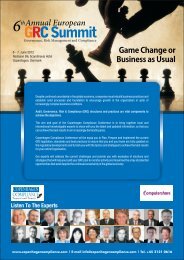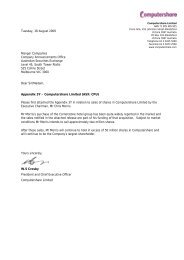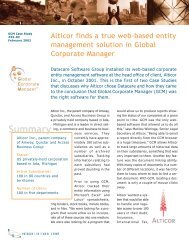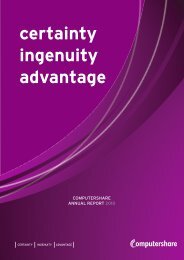ICSA Share Registration ICSA Share Registration ... - Computershare
ICSA Share Registration ICSA Share Registration ... - Computershare
ICSA Share Registration ICSA Share Registration ... - Computershare
Create successful ePaper yourself
Turn your PDF publications into a flip-book with our unique Google optimized e-Paper software.
<strong>ICSA</strong> <strong>Share</strong> <strong>Registration</strong>SummitWednesday 19 th October 2011
The case for dematerialisationMichael SansomHead of Industry Relations<strong>Computershare</strong>
The case for dematerialisation• Dematerialisation in the UK: the story so far• International experiences• Case studies on the Australian and US experience• An issuer’s view• Summary and next steps
The case for dematerialisationThe story so far• Several initiatives since the 1980s• Taurus• 2004: Project led by CrestCo• 2006: <strong>ICSA</strong> consultation and the formation of the DematReference Group• 2009/10: revisiting the 2006 model and reviewing thebusiness case• 2010: decision not to progress demat
The case for dematerialisationBack to square one?• UK Companies Act andupdated USRs designed to befacilitative• Model for dematerialisationexists, but is in need ofsignificant redesign• A structure u for consulting onand developing a 21 st centurymodel exists• More international experienceof demat
The case for dematerialisation2010: Why demat failed• Lack of market consensus• Other government priorities• A model based on 20 th century technology• No compelling business case• No issues with current market operations
The case for dematerialisationDemat back on the agenda• Early 2011: Announcement of Central SecuritiesDepositaries i (CSDs) legislationl • EU drive to harmonise trade and post trade activityacross member states• Intention to regulate functions of the CSD• Crucially, mandatory ‘book entry’ of securities throughthe member state CSD
The case for dematerialisationThe implications of ‘book entry’• Enforcing a market structure on the UK• Intermediation for retail shareholders• Reduction in register transparency• Concerns over governance implications• Grandfathering existing securities leading to a two tieredsystem• Increased costs for the market
The case for dematerialisationLobbying efforts• Detailed analysis of the proposals• Registrar and <strong>ICSA</strong> Registrars Group responses to theconsultation• Participation i in ongoing market discussionsi• Dialogue with HMT and the Commission• Concerted effort to solicit i issuer feedback
The case for dematerialisationCurrent status• Ongoing discussions to ensure UK market needs arereflected in the proposals• Commission: determined to proceed• Local markets: Scope to influence the model?• Legal analysis underway, together with a reassessmentof how a future state dematerialised model might operateaccounting for certain characteristics the UK marketwould like to see preserved
The case for dematerialisationLooking overseas• Widespread acceptance that demat has the potential todeliver market efficiencies• Important t to understand d international ti models for demat• Learn lessons and apply the latest thinking andtechnology in a future UK model
The case for dematerialisationInternational approaches to dematerialisationClaire CorneySenior Manager, MarketDevelopmentGlobal Capital Markets<strong>Computershare</strong>
The case for dematerialisationInternational approaches to dematerialisation• Range of dematerialisation models have been adoptedinternationallyti – Based on local drivers• Address two examples that t may offer useful lessons:– United States– Australia• Learn from the experience and the mistakes!
The case for dematerialisationInternational approaches to dematerialisation• Focus on operational aspects of uncertificated holdings– Legal aspects tend to be very jurisdiction specific• Each market also addresses non-trade related uses ofuncertificated shares– Pledging shares to financial institutions; takeoveracceptances etc– Generally dependent on local market practice
The case for dematerialisationUS shareholding structureIssuerDRS Certificated CEDE*DTCH H H H H HUS register of membersbrokerbrokerbrokerI I I*CEDE ‘FAST’ balance is administered by TASecurity entitlement holders
The case for dematerialisationDirect <strong>Registration</strong> System• Introduced 1996• Listing Rules require DRS ‘eligibility’DRS eligible issues 7087*DRS & certificate options 5915DRS only issues 546Certificated only 626• Est. 40 million DRS holdings in US• Investor interest– Av. 10,470* withdrawals from DTC to DRS p/mo* Statistics provided by DTC as of 15 July 2011
The case for dematerialisationDRS – Key Operational Issues1. Efficient interface between the CSD & register– STP transfer to DTC from DRS– STP withdrawal from DTC to DRS– Broker insurance2. Off market transfers of DRS holdings– Paper– Electronic3. Holding statements for DRS accounts– After change in balance only; paper
The case for dematerialisationAustralian shareholding structureIssuerIssuersponsoredAU register of membersCHESS*holder ode holder ode holder ode holder ode nominee* CHESS a/cs may be in name of nominee or investorI I IBeneficial owners
The case for dematerialisationIssuer Sponsorship• Full dematerialisation mandatory since Feb. 1999– ASX Listing Rules– 2,229229 ASX listed issuers– Estimate holdings split:57% CHESS : 43% Issuer Sponsored
The case for dematerialisationIssuer Sponsorship – Key Operational Issues1. Efficient interface between CHESS & register– STP transfer between CHESS and issuer sponsoredfor brokers• Backed by compensation fund– Institutions and custodians required to provide signedtransfer form to support transfer from issuersponsored to CHESS2. Off market transfers on Issuer Sponsored accounts– Paper-based; recent changes to prevent fraud3. Issuer Sponsored Holding statements– At end of month after change in balance only
The case for dematerialisationSummaryLessons learned:– Ongoing investor interest in the ‘on register’uncertificated holdings option– Efficiency of interface to ‘CSD’, particularly to pullshares in for settlement– Risk management for ‘off market transfers’ – findingthe right balance between efficiency and security– Evolving technology• 1996 vs 2011
The case for dematerialisationRio Tinto’s ExperienceBen MathewsCompany Secretary & GlobalHead of Secretarial ServicesRio Tinto
The case for dematerialisationIntroduction to Rio Tinto: dual listed companystructureRTP Public<strong>Share</strong>holdersCross ownershipstructureRTL Public<strong>Share</strong>holders100% ofordinary sharesRio Tinto plc("RTP") (RTP)RTPOperationsEqualisationpayments/sharesSharingAgreementIdenticalBoardsUnifiedManagementRio TintoLimited("RTL")RTLOperations
The case for dematerialisationIntroduction to Rio Tinto: dual listed companystructureConsequences of the structure• Merger creates one economic entity• Single board and governance system• Two separate listed companies- Separate shareholders, register,two AGMs- Two corporate law and three mainlisting regimes• UK and Australia companies law• LSE / ASX / NYSE listing rules• Differing registration environments for UK /Australia / US
The case for dematerialisationRio Tinto’s Experience in AustraliaDematerialised environment phased in starting in1989• Why dematerialise?• Phased in approach from 1989 to 1998• Far more efficient trading and settlement for allshareholders
The case for dematerialisationRio Tinto’s Experience in Australia1989 – introduction of Flexible Accelerated SecurityTransfer (FAST)• Similar to Crest• Uncertificated paper based transfers• FAST – used by broker trading and settlementaccounts• No impact on retail investorsEnabled T + 5 settlement regime to commence in• Enabled T + 5 settlement regime to commence in1992(previously was an unreliable T + 10)
The case for dematerialisationRio Tinto’s Experience in Australia1994 – 1998 Clearing House Electronic Subregister System (CHESS)• Extension of uncertificated holdings to custodians and retail investors• Participation in CHESS was optional – shareholder required to enteredinto a sponsorship agreement with broker• Removal of paper based on-market transfers – now electronic messages• Full dematerialisation of certificates• Default for holders who choose not to enter into a sponsorshipagreement with a broker automatically become Issuer Sponsored• Each entity listed on ASX converts their certificated holdings to IssuerSponsored holdings
The case for dematerialisationRio Tinto’s Experience in AustraliaDematerialisation – Rio Tinto Limited• Rio Tinto Limited moved to a full dematerialised system inAugust 1998• Initially a minority of shareholders were in CHESS (i.e. brokersponsored accounts)• But now-• 86% of holders are held in CHESS sponsored holdings• 93% of shares are held in CHESS sponsored holdings
The case for dematerialisationRio Tinto’s Experience in AustraliaCHESSSubregisterIssuerSponsoredSubregisterMaintained by CHESS• HIN (unique Holder IdentificationNumber)• One HIN = multiple holdings• Sponsored by CHESS participant(broker)• Statements from CHESS• Change of shareholder detailsmanaged via brokerMaintained by Issuer• SRN (unique shareholderReference Number)• One SRN = one holding• Sponsored by Issuer• Statements from Issuer• Change of shareholderdetails managed directlywith Issuer
The case for dematerialisationRio Tinto’s Experience in AustraliaDematerialisation – impact on investors• Initial i confusion about the benefits of CHESS (i.e. broker account) versusIssuer Sponsored (i.e. company account)• Phased approach to conversion from certificated to Issuer Sponsored – retailshareholders h quickly became familiar with the Issuer Sponsored concept• <strong>Share</strong>holders receive funds for trades much quicker moving from unreliableT+10 to T+3• <strong>Share</strong>holders do not have to locate or wait for replacement certificate beforeplacing/settling trade.• Enables online trading• Positively received by investors
The case for dematerialisationRio Tinto’s ExperienceBenefits of dematerialisation:• Efficiency and ease of executing trades• Cheaper and faster to administer and settle (T+3)• CHESS electronic message system now includes e-mailaddresses, bank account details and tax file numbers
The case for dematerialisationRio Tinto’s ExperienceOngoing issues for DLC:• Differing perspectives of international shareholder base/threeseparate registers: one certificated, one dematerialised; onemixed (ADR)• Opportunities for fraud remain on certificated register• Challenges for issuer – lost certificates, indemnities, extracosts for shareholders
The case for dematerialisationQ&A
<strong>ICSA</strong> <strong>Share</strong> <strong>Registration</strong>SummitWednesday 19 th October 2011
Extending <strong>Share</strong>holder Rights and CommunicationsMichael SansomHead of IndustryRelations<strong>Computershare</strong>
Extending <strong>Share</strong>holder Rights and Communications• Context and background• The European Commission view• The implications for:• Exercising voting and corporate action rights• Corporate communications with investors• EU transparency developments• <strong>Share</strong>holder visibility and case studies oncommunications with beneficial owners• Summary and next steps
Extending <strong>Share</strong>holder Rights and CommunicationsWhat is the mechanism?• Post Lehman Directive• Intended to harmonise the rules governing certain aspectsrelating to securities law – impacting securities held throughan ‘Account Provider’• Market Standards for Corporate Actions• Defining the way in which ‘information’ and ‘rights’ associatedwith corporate actions are entered into the market anddisseminated• Market Standards for General Meetings• Defining the way in which ‘information’ associated withDefining the way in which information associated withgeneral meetings is disseminated down the ownership chainand ‘rights’ are exercised
Extending <strong>Share</strong>holder Rights and CommunicationsFor what purpose? Other influencing i factors• Part of the European Union desire to create a singleharmonised European market via initiatives that addressthe position of beneficial owners of securities:• The receipt of shareholder communications; and• The exercise of shareholder rights• Additional impetus comes from:• Financial crisis and perceived failures• Governance debate and shareholders as ‘stewards’• Changes taking place to some European share ownershipmodels
Extending <strong>Share</strong>holder Rights and CommunicationsUK Market Contextt• Registered shares & legal status of ‘name on register’• Issuer obligation to communicate with registered holders• Registered holders possess direct rights against theissuer under UK law• Rights extended d post 2006 Companies Act and<strong>Share</strong>holder Rights Directive• Information Rights (s146-153) 153) and Member Rights (s145)• Right to ask questions or request an audit of a poll result• Ability to appoint multiple proxies• Transparent ownership model (s793)
Extending <strong>Share</strong>holder Rights and CommunicationsEuropean Market Contextt• Variety of market structures• More common intermediation in markets via banks,brokers and/or the local l CSD• Continued existence of bearer shares / markets• Opaque structures t of share ownership with varying rightsto drill down beyond the top level participant• Inconsistent rules, rights and obligations, particularlycross-border• Desire to harmonise and generate efficiencies to bettercompete with markets such as the US
Extending <strong>Share</strong>holder Rights and CommunicationsQuestions the market needs to ask• How do the proposals impact the rights of shareholdersin the UK?• What are the implications for how shareholderh communications are distributed and to whom?• What are the consequences for how shareholdersexercise rights attaching to securities that they own?• Do the proposals affect the timetables for events such asgeneral meetings or corporate actions?• Is there an impact on our system of governance?• What is the cost/benefit for the UK market?
Extending <strong>Share</strong>holder Rights and CommunicationsChris RedmondSeconded d National ExpertEuropean Commission
Extending <strong>Share</strong>holder Rights and CommunicationsAndy CallowSenior Manager, MarketDevelopmentGlobal Capital Markets<strong>Computershare</strong>
Extending <strong>Share</strong>holder Rights and CommunicationsExercising i Voting Rights• Current UK registered model– Voting through the intermediary chain– Proxy appointment/POA– Use of Proxy Agents
Extending <strong>Share</strong>holder Rights and CommunicationsExercising Voting Rights• Draft PLD proposals– Flow of information through the intermediary chain– Cost sharing?– Direct exercise of rights
Extending <strong>Share</strong>holder Rights and CommunicationsExercising Voting Rights• Challenges of Direct Exercise– Proof of entitlement– Data collection– Notice generation– Processing efficiency– Infrastructure provider?– Record date positioning• Are designated accounts the answer?
Extending <strong>Share</strong>holder Rights and CommunicationsExercising Corporate Action Rights• Dividends id d – Interim Securities– No evergreen elections– Partial elections can be drip-fed– Mandatory election period– Consistent default for CSD participantsp– Other considerations• Costs• Documentationti• Education
Extending <strong>Share</strong>holder Rights and CommunicationsExercising Corporate Action Rights• Book Entry Payments via CSD– Questionable demand– Reduced flexibility - Cash Memorandum Account vs. BACS– Opt-in service vs. Default
Extending <strong>Share</strong>holder Rights and CommunicationsExercising Corporate Action Rights• Fulfillment timescales• Securities Distribution – Recommended date sequence• UK Sequence - Price sensitive events e.g. Rights Issue• Fair treatment of shareholders• Extension of timetable• Underwriting implications
Extending <strong>Share</strong>holder Rights and CommunicationsCorporate Communications• Current Model– Information Providers (RNS, PR Newswire, SSN)– Data Vendors– Cleansing– Reselling• Alternatives– Central Infrastructure (e.g. CSD facility)– Issuer Agent Solution– XBRL• Liability
Extending <strong>Share</strong>holder Rights and CommunicationsPeter SwabeyCompany Secretary and IndustryLeadership Director
Extending <strong>Share</strong>holder Rights and CommunicationsEU TransparencyDevelopments
Extending <strong>Share</strong>holder Rights and CommunicationsAgenda• The importance of transparency in relation to governance• European markets and the challenge they have with visibility• UK law – the glory of Section 793• T2S and the work of the transparency taskforce
Extending <strong>Share</strong>holder Rights and CommunicationsWhy is transparency important t ?• Good stewardship:In any stewardship system, managers age are responsible s e for managing ag g acompany in the best interests of its owners, but how can they do soeffectively if they do not know who those owners are ?• Engagement between managers and owners:C t ti d b t d t b t i d th iConstructive debate and engagement between issuers and theirshareholders leads to better governance, and enables managers totake the views of the owners into account in their planning which ismore constructive than waiting for a shareholder vote to assessshareholder sentiment.
Extending <strong>Share</strong>holder Rights and CommunicationsEU Transparency Rules• Wide variety of rules in Member States• Transparency Directive requirement for disclosure at 5%and above• Gold-plated in the UK – 3% and above• Most member states have something but efficacyvariable, with restrictions on:– Scope of enquiries: eg holdings above a certain size– Timing of enquirie : eg at a time related to the AGM– Frequency of enquiries etc
Extending <strong>Share</strong>holder Rights and CommunicationsEU Transparency Rules• Timing rules can create issues – only enquiring ahead of acorporate action lets the cat out of the bag, and creates arisk of market abuse if it is price sensitive• In some Member States, issuers have to payintermediaries to provide ownership information• Who is the shareholder? h No common definitioniti• Solution is to have a registered share model!
Extending <strong>Share</strong>holder Rights and CommunicationsEU Transparency Rules
Extending <strong>Share</strong>holder Rights and CommunicationsEU Transparency Rules
Extending <strong>Share</strong>holder Rights and CommunicationsEU Transparency Rules
Extending <strong>Share</strong>holder Rights and CommunicationsUK Legal position – s793• Part 22 of the Companies Act gives a public company verywide-ranging powers to identify underlying investors• A section 793 notice :– May be sent to anyone that the company “knows or has reasonable cause tobelieve” to be ‘interested’ in its shares now or at any time in the last threeyears– May require confirmation of any interest and details of the nature of thatinterest, including the identity of any other person(s) interested in the sharesparticularly (if he knows) the identity of the person who held that interestimmediately afterwards– May demand information “within such reasonable time as may be specified inthe notice” – and 48 hours has been held in Court to be a reasonable time
Extending <strong>Share</strong>holder Rights and CommunicationsPart 22 – Penalties : Civilil• Where a s793 notice is served, and no response is received,the Issuer can apply to the Court for an order imposingrestrictions ti on the shares, which h can include that: t– any transfer of the shares is void;– the shares lose their voting rights;– the shares lose any right to any rights issue or to accept a takeover offer– no further shares may be issued in right of the shares or in pursuance of anoffer made to their holder; and– the company ceases to be liable to make any payment – capital or otherwise(eg dividends) in respect of the shares.• Note that the Articles may provide for further sanctions
Extending <strong>Share</strong>holder Rights and CommunicationsPart 22 – Penalties : criminali • Failure to respond to a s793 notice, or to deliberatelyor recklessly give a false response is a criminaloffence, the penalty for which is:– Imprisonment for up to two years; or– A fine; or– Both.
Extending <strong>Share</strong>holder Rights and CommunicationsPart 22 – Penalties : criminali
Extending <strong>Share</strong>holder Rights and CommunicationsWhy is transparency important t ?• But it is a two-way processWhere information is obtained under s793, s808 obliges thecompany to keep a register of interests disclosed – ie thefact that a s793 notice has been issued and anyinformation received in responseThis register is also a public document – anyone has theright to inspect or obtain copies on payment of thestatutory fee, subject only to a ‘proper purpose’ test.
Extending <strong>Share</strong>holder Rights and CommunicationsWhy is transparency important t ?• So shareholder visibility in the UK has four strands:– Obligation to report share ownership over fixed thresholds;– Ability for issuers to demand information– Legal penalties for failure to provide information– Information provided is in the public domain• This means that ultimate ownership of UK companies isnot secret – it is a matter of public record• The right to the benefit of limited liability brings with it theduty of transparency of ownership
Extending <strong>Share</strong>holder Rights and CommunicationsT2S - the transparency taskforce• ECB project to create a single pan-European settlementsystem• Planned implementation in 2014• Risk for UK issuers a loss of transparency• Also concerns about cost, governance, certainty ofownership etc
Extending <strong>Share</strong>holder Rights and CommunicationsT2S - the transparency taskforce
Extending <strong>Share</strong>holder Rights and CommunicationsT2S - the transparency taskforce• A number of issuers raised this issue with the ECB• Taskforce (with 23 members from 12 member states) established to:– Explore the prospects of EU legal l harmonisation i in cross-bordershareholder transparency;– Assess the possibility of harmonised market practices in disclosingshareholders information;– further discuss alternative proposals as to the establishment of atechnical solution for the cross-border exchange of shareholdersinformation; and– provide the T2S Advisory Group with a report on these aspects.
Extending <strong>Share</strong>holder Rights and CommunicationsT2S - the transparency taskforce• The taskforce recommended that:– The development of a pan-European right for issuers to obtainshareholder information would improve transparency;– This could be achieved through amendments to the TransparencyDirective – but anything would do ;– A standard message format should be developed through ISO toensure consistency of approach; and– This should be agreed by all market participants.
Extending <strong>Share</strong>holder Rights and CommunicationsT2S - the transparency taskforce• Work has been done to:– Draft some ISO message formats;– Identify protocols as to what data should be supplied;• If this functionality is built, into T2S, the messages could be passed upand down the chain as STP• Now less of an issue following Bank of England decision that sterlingwill not take part
Extending <strong>Share</strong>holder Rights and CommunicationsEU Transparency Rules
Extending <strong>Share</strong>holder Rights and CommunicationsCas SydorowitzCEO
Extending <strong>Share</strong>holder Rights and Communications<strong>Share</strong>holder h Visibilityibili• Does your Register show the ultimate decision makers?• Can you communicate with those decision makers?• As Co Sec are you responsible for knowing who youry p g yshareholders are?
Extending <strong>Share</strong>holder Rights and Communications<strong>Share</strong> Register ExampleRegister Sorted in Alpha OrderRegister Sorted in Descending Order
Extending <strong>Share</strong>holder Rights and CommunicationsOwnership Analysis
Extending <strong>Share</strong>holder Rights and Communications<strong>Share</strong>holder h vs. Proxy Advisors• Who decides how to vote?• Growing influence of Proxy advisors
Extending <strong>Share</strong>holder Rights and CommunicationsSample proxy advisor reports78
Extending <strong>Share</strong>holder Rights and CommunicationsRegistered holder vs. Voting agent• Custodians outsource the notification and collection ofinstructions• An extra step in the ownership chain for communicatingvoting instructions
Extending <strong>Share</strong>holder Rights and CommunicationsOwnership chain – investment advisors
Extending <strong>Share</strong>holder Rights and CommunicationsCase study: Communicating i with beneficial i ownersEGM, May 2010• Strategic objective: To defend against an activist and approveseveral strategic items for the ongoing running of the company• 10 brokers were approached– 793 letters issued to these brokers to obtain their clients details– Letters were written to all the underlying holders with a form ofdirection allowing them to submit their instructions• Online & hard copy forms– Responses were bundled and returned for each broker, for theirsubmission to the registrar
Extending <strong>Share</strong>holder Rights and CommunicationsCase study: Communicating i with beneficial i ownersEGM, May 2010• Strategic objective: To defend against an activist and approveseveral strategic items for the ongoing running of the company– The beneficial owners represented 55% of the ISC which wouldnot have been part of the process through no active engagementwith the beneficial i owners• Results: An additional 67m (13%) votes were cast at the meeting
Extending <strong>Share</strong>holder Rights and CommunicationsCase study: Communicating i with beneficial i owners
Extending <strong>Share</strong>holder Rights and CommunicationsQ&A
<strong>ICSA</strong> <strong>Share</strong> <strong>Registration</strong>SummitWednesday 19 th October 2011



